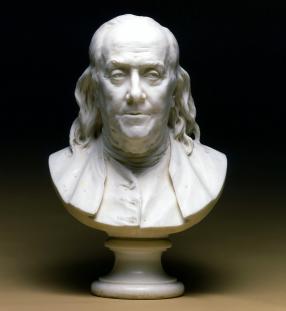Portrait bust of Benjamin Franklin (Houdon - PMA), 1779
|
Franklin is depicted with his head forward and barely inclined. His eyes gaze toward his right, and his lips are parted slightly, his forehead is creased, and his brows draw together over the bridge of his nose. His left brow is arched somewhat. His lips are parted slightly, and the sides of his mouth dimple, as though in speech. There is evidence of hair on the crown of his head, and it falls loosely to his shoulders. The lapels of his coat are open; the seam of the collar at his neckline is indicated. The top button of his waistcoat is fastened, two lower buttonholes are open and indicated in careful detail, stitching and thickening of the cloth around them. His shirt is gathered at the neckband, and his neckcloth indicated wrapped around his neck. The front of the bust is cut away in a half-circle above the middle of Franklin's chest; the sides are thick and have an irregular profile; the back ends in an almost straight edge just beneath the subject's hair. It is signed along this truncated edge "F.P.HOUDON EN 1779." The bust is positioned on a short turned pedestal or socle.
The rage for likenesses of Franklin during his tenure in France resulted in images ranging from marble busts and paintings to prints, miniatures, and ceramic representations. Houdon's has been called the most powerful and fully realized portrait of Franklin, though Franklin did not sit formally for him. It has been suggested that Houdon drew upon his experience of seeing Franklin at meetings of the Masonic lodge to which they both belonged. Certainly, Franklin's active public life made him easy to observe. A marble bust, now owned by the Metropolitan Museum of Art, and one in terra cotta, now owned by the Louvre, date to 1778. In 1779, Houdon exhibited a bust of Franklin in the Salon exhibition of the French Royal Academy, and also in the Masonic "Lodge of the Nine Sisters [Muses]." Like other sculptors, Houdon sent works to the Salon to attract orders for reproductions in various materials. Using molds, he could produce copies in plaster and terra cotta to which he added distinctive touches. Several of these survive.
Some of the other Houdon busts known at the time of this entry (1/2006) include: in terra cotta: Louvre (Sellers #1). Plaster casts: American Academy of Arts & Sciences, Cambridge (Sellers #6); Musée Fabre, Montpellier, France (not in Sellers); Schlossmuseum Gotha, Gotha, Germany (not in Sellers); American Academy of Arts and Sciences, Cambridge, Massachusetts. Dean Walker, writing in Poulet, cited this last as possibly the bust bought by Jefferson and on display at Monticello during his lifetime. Marble: Metropolitan Museum of Art (Sellers #8).
|
||





